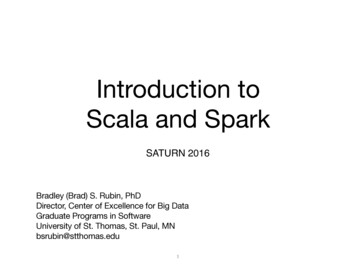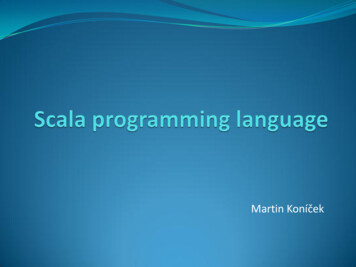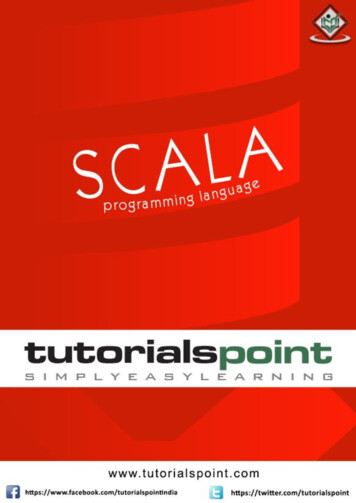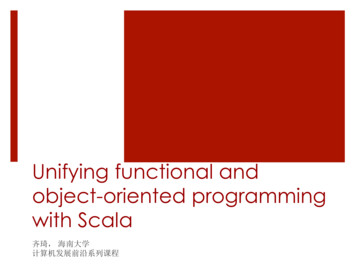
Transcription
The Seductions ofScalaDean otprogramming.com/talksJuly 23, 20151Thursday, July 23, 15The online version contains more material. You can also find this talk and the code used formany of the examples at eductionsOfScala.Copyright 2010-2015, Dean Wampler. Some Rights Reserved - All use of the photographsand image backgrounds are by written permission only. The content is free to reuse, butattribution is c-sa/2.0/legalcode
FunctionalProgrammingfor Java DevelopersDean Wampler shameless-plug/ 2Thursday, July 23, 15My books.
Why did weneed a newlanguage?3Thursday, July 23, 15I picked Scala to learn in 2007 because I wanted to learn a functional language. Scala appealed because it runs on the JVM and interoperates withJava. In the end, I was seduced by its power and flexibility.
#1We needFunctionalProgramming 4Thursday, July 23, 15First reason, we need the benefits of FP.
for concurrency. for concise code. for correctness.5Thursday, July 23, 15
#2We need a betterObject Model 6Thursday, July 23, 15
for composability. for scalable designs.7Thursday, July 23, 15Java’s object model (and to a lesser extent, C#‘s) has significant limitations.
Scala’s Thesis:Functional Prog.complementsObject-OrientedProg.Despite surface contradictions.8Thursday, July 23, 15We think of objects as mutable and methods as state-modifying, while FP emphasizes immutability, which reduces bugs and often simplifiescode. Objects don’t have to be mutable!
But we needto keepour investmentin Java.9Thursday, July 23, 15We rarely have the luxury of starting from scratch.
Scala is. A JVM language. Functional and object oriented. Statically typed. An improved Java.10Thursday, July 23, 15There has also been work on a .NET version of Scala, but it seems to be moving slowly.
Martin Odersky Helped design java generics. Co-wrote GJ that becamejavac (v1.3 ). Understands CS theory andindustry’s needs.11Thursday, July 23, 15Odersky is the creator of Scala. He’s a prof. at EPFL in Switzerland. Many others have contributed to it, mostly his grad. students.GJ had generics, but they were disabled in javac until v1.5.
Big Data is theKiller App forFunctional Programming12Thursday, July 23, 15This talk has evolved a lot in the 6 years I’ve been giving it. Right now, the most compelling argument for Scala is that it’s the best language we have for writingBig Data applications (e.g., for Hadoop clusters), as exemplified by several tools.So for motivation, here’s a teaser of where we’re headed.
Inverted Indexinverse indexwikipedia.org/hadoopHadoop providesMapReduce and ./hive,1).wikipedia.org/hbaseHBase stores data in HDFS.block.block.wikipedia.org/hiveHive queries HDFS files andHBase tables with SQLblock.and(./hadoop,1),(./hive,1).13Thursday, July 23, 15What we want to do, read a corpus, in this case Wikipedia pages, where we use the URL as thedoc Id as the key and the contents as the value. We will tokenize into words, and “invert” theindex so the words are keys and the values are a list of “tuples”, “(id1, count1), (id2,count2), .”, for the corresponding word.
Spark: Inverted Index.sparkContext.textFile("/path/to/input").map { line val array line.split(",", 2)(array(0), array(1)) // (id, text)}.flatMap {case (id, text) tokenize(text).map(word ((word, id), 1))}.reduceByKey {(count1, count2) count1 count2}.map {case ((word, id), n) (word, (id, n))}.groupByKey// (w1, list((id11,n11), (id12,n12), .)).saveAsTextFile("/path/to/output")14Thursday, July 23, 15The inverted index algorithm in Spark, which ingests an identifier for a document (e.g., web page) and the contents of it, then “inverts” that data outputting each word in the texts globally andall the documents where it’s found, plus its count in each document.I won’t explain the details now, but they should be easier to understand once we’re through. The gist of the algorithm is this: Using the entry point, a SparkContext instance, we load sometext files, then map over each line of text to split it on the first comma, returning a two-element “tuple” with the first and second elements from the Java array that results from splitting. Theyare the document id and the text. Next we “flat map” over those tuples. While map is transforms one input to one output (1-to-1), flatMap transforms one input to 0-to-many outputs. Here weuse it tokenize text into worlds and outputs a new 2-tuple, where the first element is itself a 2-tuple (word, id) and a “seed” count of 1 is the second element in the outer tuple. reduceByKey isan optimized groupBy, using the (word,id) keys, when we just need to “reduce” the rest of the outer tuples. In this case, we add the “1”s. Now we have a total count of (word,id) pairs. Thenext step converts those tuples to (word, (id,n)) tuples, after which we group over the words, and now we have the final result, which we write out.
Objectscan beFunctions15Thursday, July 23, 15Let’s go back and build up to understanding what we just saw. First, objects can behave like “functions”, (although not all objects do this).
class Logger(val level:Level) {def apply(message: String) {// pass to Log4J.Log4J.log(level, message)}}16Thursday, July 23, 15A simple wrapper around your favorite logging library (e.g., Log4J).
makes level an immutable fieldclass Logger(val level:Level) {}def apply(message: String) {// pass to Log4J.Log4J.log(level, message)}methodclass body is the“primary” constructor17Thursday, July 23, 15Note how variables are declared, “name: Type”.
class Logger(val level:Level) {def apply(message: String) {// pass to Log4J.Log4J.log(level, message)}}returns and semicolons inferred18Thursday, July 23, 15No need for return keywords or semicolons (in most cases).
class Logger(val level:Level) {def apply(message: String) {// pass to Log4J.Log4J.log(level, message)}}val error new Logger(ERROR) error("Network error.")19Thursday, July 23, 15After creating an instance of Logger, in this case for Error logging, we can “pretend” the object is a function!
class Logger(val level:Level) {def apply(message: String) {// pass to Log4J.Log4J.log(level, message)}}apply is called error("Network error.")20Thursday, July 23, 15Adding a parameterized arg. list after an object causes the compiler to invoke the object’s “apply” method.
“function object” error("Network error.")When you putan argument listafter any object,apply is called.21Thursday, July 23, 15This is how any object can be a function, if it has an apply method. Note that the signature of the argument list must match the arguments specified. Remember, this is a statically-typedlanguage!
More onMethods22Thursday, July 23, 15
A singleton objectobject Error {}def apply(message: String) {// pass to Log4J.Log4J.log(ERROR, message)}Like a static methodapply is called Error("Network error.")23Thursday, July 23, 15Adding a parameterized arg. list after an object causes the compiler to invoke the object’s “apply” method.
Infix Operator Notation"hello" "world"is actually just"hello". ("world")24Thursday, July 23, 15Note the “infix operator notation”; x.m(y) x m y. Why? Scala lets you use more characters for method names, like math symbols, so this syntax looks more natural.
JavaPrimitives?25Thursday, July 23, 15A side note on Java primitives
Int, Double, etc.are true objects, butScala compiles themto primitives.26Thursday, July 23, 15If you know Java, you might wonder if these integer lists were actually List Integer , the boxed type. No. At the syntax level, Scala only has object (reference) types, but it compiles thesespecial cases to primitives automatically.
This means thatgenerics just work.val l List.empty[Int]An empty list of Ints.Java? . List Int 27Thursday, July 23, 15You don’t have to explicitly box primitives; the compiler will optimize these objects to primitives (with some issues involving collections.)Note the syntax for parameterizing the type of List, [.] instead of . .
Functions areObjects28Thursday, July 23, 15While an object can be a function, every “bare” function is actually an object, both because this is part of the “theme” of scala’s unification of OOP and FP, but practically, because the JVMrequires everything to be an object!
Classic Operations onContainer TypesList, Map, .mapfilterfold/reduce29Thursday, July 23, 15Collections like List and Map are containers. So are specialized containers like Option (Scala) or Maybe (Haskell) and other “monads”.
Seq.applyval seq1 Seq("a", "b")// seq1: List[String] List(a,b)val seq2 seq1.map {s s.toUpperCase}// seq2: List[String] List(A,B)30Thursday, July 23, 15The comment is what the Scala intepreter shell would echo back to you.Let’s map a list of strings with lower-case letters to a corresponding list of uppercase strings.
map called on seq1(dropping the “.”)argument to map: canuse “{.}” or “(.)”seq1 map {s s.toUpperCase}functionargument list“function literal”function body31Thursday, July 23, 15Note that the function literal is just the “s s.toUpperCase”. The { } are used like parentheses around the argument to map, so we get a block-like syntax.
Typed Argumentsseq1 map {s s.toUpperCase}inferred typeseq1 map {(s:String) s.toUpperCase}Explicit type32Thursday, July 23, 15We’ve used type inference, but here’s how we could be more explicit about the argument list to the function literal. (You’ll find some contexts where you have to specify these types.)
But wait! There’s more!list map {s s.toUpperCase}Placeholderlist map ( .toUpperCase)33Thursday, July 23, 15We have this “dummy” variable “s”. Can we just eliminate that boilerplate?I used an informal convention here; if it all fits on one line, just use () instead of {}. In fact, you can use () across lines instead of {}. (There are two special cases where using () vs. {} matters:1) using case classes, the literal syntax for a special kind of function called a PartialFunction - {} are required, and 2) for comprehensions, - as we’ll see.)
Watch this.list foreach (s println(s))list foreach (println)// the same as:list foreach println“Point-free” style34Thursday, July 23, 15Scala doesn’t consistently support point-free style like some languages, but there are cases like this where it’s handy; if you have a function that takes a single argument, you can simplypass the function as a value with no reference to explicit variables at all!
So far,we have usedtype inferencea lot.35Thursday, July 23, 15
How the Sausage Is MadeParameterized typeclass List[A] {Declaration of map def map[B](f: A B): List[B] }map’s return typeThe functionargument36Thursday, July 23, 15Here’s the declaration of List’s map method (lots of details omitted ). Scala uses [.] for parameterized types, so you can use “ “ and “ ” for method names!Note that explicitly show the return type from map (List[B]). In our previous examples, we inferred the return type. However, Scala requires types to be specified on all method arguments!
How the Sausage Is Madelike a Java 8 interface“contravariant”,“covariant” typingtrait Function1[-A, R] {def apply(a:A): R No method body,}therefore it is abstract37Thursday, July 23, 15We look at the actual implementation of Function1 (or any FunctionN). Note that the scaladocs have links to the actual source listings.(We’re omitting some details ) The trait declares an abstract method “apply” (i.e., it doesn’t also define the method.)Traits are a special kind of abstract class/interface definition, that promote “mixin composition”. (We won’t have time to discuss )
What the Compiler Doess s.toUpperCaseWhat you write.new Function1[String,String] {def apply(s:String) {s.toUpperCaseWhat the compiler}generates}An anonymous class38Thursday, July 23, 15You use the function literal syntax and the compiler instantiates an anonymous class using the corresponding FunctionN trait, with a concrete definition of apply provided by your functionliteral.
Functions are Objectsval seq1 Seq("a", "b")// seq1: List[String] List(a,b)val seq2 seq1.map {s s.toUpperCase}Function “object”// seq2: List[String] List(A,B)39Thursday, July 23, 15Back to where we started. Note again that we can use “{ }” instead of “( )” for the argument list (i.e., the single function) to map. Why, to get a nice block-like syntax.
Big Data DSLs40Thursday, July 23, 15FP is going mainstream because it is the best way to write robust data-centric software, such as for “Big Data” systems like Hadoop. Here’s an example.
Spark: ReplacingMapReduce in Hadoop Written In ScalaAPI based on Scala collections APIhttp://spark.apache.org41Thursday, July 23, 15I found MapReduce incredibly frustrating when I started doing Hadoop. It’s a very limited programming model, with poor performance, and a terrible API in Hadoop, specifically.
Let’s revisit theInverted Indexalgorithm.42Thursday, July 23, 15
Inverted Indexinverse indexwikipedia.org/hadoopHadoop providesMapReduce and ./hive,1).wikipedia.org/hbaseHBase stores data in HDFS.block.block.wikipedia.org/hiveHive queries HDFS files andHBase tables with SQLblock.and(./hadoop,1),(./hive,1).43Thursday, July 23, 15What we want to do, read a corpus, in this case Wikipedia pages, where we use the URL as thedoc Id as the key and the contents as the value. We will tokenize into words, and “invert” theindex so the words are keys and the values are a list of “tuples”, “(id1, count1), (id2,count2), .”, for the corresponding word.
import org.apache.spark.SparkContextobject InvertedIndex {def main(args: Array[String]) {val sparkContext new ut").sparkContext.stop()}}What we had before.44Thursday, July 23, 15Now a full program for the Inverted Index. Note that the stuff in “main” could also be run interactively or as a script in a version of the Scala console called the Spark Shell, even on a cluster!!
sparkContext.textFile("/path/to/input").map { line val array line.split(",", 2)(array(0), array(1)) // (id, text)}.flatMap {case (id, text) tokenize(text).map(word ((word, id), 1))}.reduceByKey {(count1, count2) count1 count2}.map {case ((word, id), n) (word, (id, n))}.groupByKey// (w1, list((id11,n11), (id12,n12), .)).saveAsTextFile("/path/to/output")45Thursday, July 23, 15This is a SINGLE expression, although you could break up the steps and assign them to variables. Let’s walk through it.
sparkContext.textFile("/path/to/input").map { line val array line.split(",",2) from files,Load data(array(0), array(1)) // (id, text)e.g.,inHDFS}.flatMap {case (id, text) tokenize(text).map(Each step returns aword ((word, id), 1))}.reduceByKey {new RDD: Resilient(count1, count2) count1 count2DistributedDataset}.map {case ((word, id), n) (word, (id, n))}.groupByKey// (w1, list((id11,n11), (id12,n12), .)).saveAsTextFile("/path/to/output")46Thursday, July 23, 15RDDs are distributed data sets. Your data is partitioned and each partition is computed over in a separate JVM process, giving you parallelism.
sparkContext.textFile("/path/to/input").map { line val array line.split(",", 2)(array(0), array(1)) // (id, text)}.flatMap {case (id, text) tokenize(text).map(Split each line on theword ((word, id),1st1))“,”. Return a 2-tuple}.reduceByKey {holdingthe resulting(count1, count2) count1 count2}.map {“id” and “text”case ((word, id), n) (word, (id, n))}.groupByKey// (w1, list((id11,n11), (id12,n12), .)).saveAsTextFile("/path/to/output")47Thursday, July 23, 15Note the elegant (a,b,c,d) tuple syntax.
What you write.(1, “two”, 3.14)new Tuple3[Int,String,Double] {private val first 1private val second “two”private val third 3.14def 1:Int firstdef 2:String seconddef 3:Double third}What the compilergenerates (sort of)48Thursday, July 23, 15Note the elegant (a,b,c,d) tuple syntax.
sparkContext.textFile("/path/to/input").map { line val array line.split(",", 2)(array(0), array(1)) // (id, text)}.flatMap {case (id, text) tokenize(text).map(word ((word, id), 1))}.reduceByKey {(count1, count2) count1 count2Tokenizethe text into}.map {words,returna2-tuplecase ((word, id), n) (word, (id, n))with another 2-tuple}.groupByKey// (w1, list((id11,n11),(word,(id12,n12),id) and a.))seed.saveAsTextFile("/path/to/output")count of 149Thursday, July 23, 15Note the elegant (a,b,c,d) tuple syntax.
Pattern Matchingval string value match {case 1 “one”case “two” “two”case d: Double “double”case ((a,b),c) s“3-tuple: a, b, c”case unknown “unknown”}50Thursday, July 23, 15Power tool for determining the type, matching on specific values or general positions and for the latter, assigning a variable to the matched elements, so it’s also very convenient for “destructuring” values. Note that the s”.” is an interpolated string where the variables referenced with “ a” etc will be filled in.
sparkContext.textFile("/path/to/input").map { line val array line.split(",", 2)(array(0), array(1)) // (id, text)}.flatMap {case (id, text) tokenize(text).map(word ((word, id), 1))}.reduceByKey {(count1, count2) count1 count2}.map {case ((word, id), n) (word, (id, n))}.groupByKey// (w1, list((id11,n11), (id12,n12), .)).saveAsTextFile("/path/to/output")51Thursday, July 23, 15Note the elegant (a,b,c,d) tuple syntax.
sparkContext.textFile("/path/to/input").map { line val array line.split(",", 2)(array(0), array(1)) // (id, text)}.flatMap {case (id, text) tokenize(text).map(word ((word, id), 1))}.reduceByKey {(count1, count2) count1 count2}.map {case ((word, id), n) (word, (id, n))Like group by followed}.groupByKey// (w1, list((id11,n11), (id12,n12),.))but the d to add the 1s.52Thursday, July 23, 150-to-many output. Pattern matching is used to extract the tuple elements into named variables.
sparkContext.textFile("/path/to/input").map { line val array line.split(",", 2)(array(0), array(1)) // (id, text)}.flatMap {case (id, text) tokenize(text).map(word ((word, id), 1))}.reduceByKey {(count1, count2) count1 count2}.map {case ((word, id), n) (word, (id, n))}.groupByKey// (w1, list((id11,n11), (id12,n12), .)).saveAsTextFile("/path/to/output")Now make the “word” thekey and group over words.53Thursday, July 23, 150-to-many output. Pattern matching is used to extract the tuple elements into named variables.
sparkContext.textFile("/path/to/input").map { line val array line.split(",", 2)(array(0), array(1)) // (id, text)}.flatMap {case (id, text) tokenize(text).map(word ((word, id), 1))}.reduceByKey {(count1, count2) count1 count2}.map {case ((word, id), n) (word, (id, n))}.groupByKeySave to the file system// (w1, list((id11,n11), (id12,n12), .)).saveAsTextFile("/path/to/output")54Thursday, July 23, 150-to-many output. Pattern matching is used to extract the tuple elements into named variables.
For more on Sparksee my ursday, July 23, 15https://github.com/deanwampler/spark-workshop
MoreFunctionalHotness56Thursday, July 23, 15FP is also going mainstream because it is the best way to write robust concurrent software. Here’s an example.
Avoiding Nullssealed abstract class Option[ T]{ }case class Some[ T](value: T)extends Option[T] { }case object Noneextends Option[Nothing] { }57Thursday, July 23, 15I am omitting MANY details. You can’t instantiate Option, which is an abstraction for a container/collection with 0 or 1 item. If you have one, it is in a Some, which must be a class, since it hasan instance field, the item. However, None, used when there are 0 items, can be a singleton object, because it has no state! Note that type parameter for the parent Option. In the typesystem, Nothing is a subclass of all other types, so it substitutes for instances of all other types. This combined with a property called covariant subtyping means that you could write “val x:Option[String] None” and it would type correctly, as None (and Option[Nothing]) is a subtype of Option[String]. Note that Options[ T] is only covariant in T because of the “ ” in front of theT.Also, Option is an algebraic data type, and now you know the scala idiom for defining one.
// Java style (schematic)class Map[K, V] {def get(key: K): V {return value null;}}// Scala styleclass Map[K, V] {def get(key: K): Option[V] {return Some(value) None;}}Which is the better API?58Thursday, July 23, 15Returning Option tells the user that “there may not be a value” and forces proper handling, thereby drastically reducing sloppy code leading to NullPointerExceptions.
In Use:val m Map(("one",1), ("two",2)) val n m.get("four") match {case Some(i) icase None 0 // default}Use pattern matching to extract the value (or not)59Thursday, July 23, 15Here’s idiomatic scala for how to use Options. Our map if of type Map[String,Int]. We match on the Option[V] returned by map.get. If Some(i), we use the integer value I. If there is no value forthe key, we use 0 as the default. Note: Option has a short-hand method for this idiom: m.getOrElse(“four”, 0).
Option Details: sealedsealed abstract class Option[ T]{ }All children must be definedin the same file60Thursday, July 23, 15I am omitting MANY details. You can’t instantiate Option, which is an abstraction for a container/collection with 0 or 1 item. If you have one, it is in a Some, which must be a class, since it hasan instance field, the item. However, None, used when there are 0 items, can be a singleton object, because it has no state! Note that type parameter for the parent Option. In the typesystem, Nothing is a subclass of all other types, so it substitutes for instances of all other types. This combined with a proper called covariant subtyping means that you could write “val x:Option[String None” it would type correctly, as None (and Option[Nothing]) is a subtype of Option[String].
Case Classescase class Some[ T](value: T) case keyword makes thevalue argument a field (valkeyword not required). equals, hashCode, toString.61Thursday, July 23, 15
Case Classescase class Some[ T](value: T) singleton object with a factoryapply method pattern matching support. .62Thursday, July 23, 15
Scala’s ObjectModel: TraitsComposable Units of Behavior63Thursday, July 23, 15Fixes limitations of Java’s object model.
We would like tocompose objectsfrom mixins.64Thursday, July 23, 15
Java: What to Do?class Serverextends Logger { }“Server is a Logger”?class Serverimplements Logger { }Better conceptually.65Thursday, July 23, 15Made-up example Java type. The “is a” relationship makes no sense, but the Logger we implemented earlier isn’t an interface either.
Java’s object model Good Promotes abstractions. Bad No composition throughreusable mixins.66Thursday, July 23, 15Chances are, the “logging” and “filtering” behaviors are reusable, yet Java provides no built-in way to “mix-in” reusable implementations. Ad hoc mechanisms must be used.
TraitsInspired Java 8interfaces;add methodimplementationsand state.67Thursday, July 23, 15Java 8 interfaces don’t support state (i.e., what will become fields in a class that mixes in the trait).
Logger as a Mixin:trait Logger {val level: Level // abstractdef log(message: String) {Log4J.log(level, message)}}Traits don’t haveconstructors, but youcan still define fields.68Thursday, July 23, 15I changed some details compared to our original Logger example. Traits don’t have constructor argument lists (for various technical reasons), but we can define fields for them, as shown.Here, I make the field abstract, which means that any class that mixes in the trait will have to define “level”.
Logger as a Mixin:trait Logger {val level: Level // abstract.}mixed in Loggingval server new Server( ) with Logger {val level ERRORabstract}member definedserver.log("Internet down!!")69Thursday, July 23, 15Note that could have declared a type, say “class ServerWithLogger( ) extends Server(.) with Logger { }, but if you only need one instance, we can just do it “on the fly!” Note that the levelis defined as a body for this object, much the same way you define an anonymous inner class and define its abstract members.
Like Java 8 Interfaces Default methods Can define method bodies.X Fields J8 fields remain static final,not instance fields.70Thursday, July 23, 15Java 8 interfaces aren’t quite the same as traits. Fields remain static final, for backwards compatibility, but now you can define method bodies, which will be the defaults used if a classdoesn’t override the definition.
Recap71Thursday, July 23, 15
Scala is.72Thursday, July 23, 15
a better Java,73Thursday, July 23, 15
object-orientedandfunctional,74Thursday, July 23, 15
succinct,elegant,andpowerful.75Thursday, July 23, 15
Questions?Dean otprogramming.com/talksJuly 23, 201576Thursday, July 23, 15The online version contains more material. You can also find this talk and the code used formany of the examples at eductionsOfScala.Copyright 2010-2013, Dean Wampler. Some Rights Reserved - All use of the photographsand image backgrounds are by written permission only. The content is free to reuse, butattribution is c-sa/2.0/legalcode
Extra Slides77Thursday, July 23, 15
Lists and Maps78Thursday, July 23, 15
ListsList.apply()val list List(1, 2, 3, 4, 5)The same as this “list literal” syntax:val list 1 :: 2 :: 3 :: 4 :: 5 :: Nil79Thursday, July 23, 15Why is there no “new”? You can guess what’s going on based on what we’ve already said. There must be some object named “List” with an apply method.In fact, there is a “singleton” object named List that is a “companion” of the List class. This companion object has an apply method that functions as a factory for creating lists.
“cons”empty listval list 1 :: 2 :: 3 :: 4 :: 5 :: Nilheadtail80Thursday, July 23, 15We build up a literal list with the “::” cons operator to prepend elements, starting with an empty list, the Nil “object”.
Baked into theGrammar?val list 1 :: 2 :: 3 :: 4 :: 5 :: NilNo, just method calls!val list Nil.::(5).::(4).::(3).::(2).::(1)81Thursday, July 23, 15But this isn’t something backed into the grammar; we’re just making method calls on the List type!
val list 1 :: 2 :: 3 :: 4 :: 5 :: Nilval list Nil.::(5).::(4).::(3).::(2).::(1)Method names can contain almost anycharacter.82Thursday, July 23, 15There are some restrictions, like square brackets [ and ], which are reserved for other uses.
val list 1 :: 2 :: 3 :: 4 :: 5 :: Nilval list Nil.::(5).::(4).::(3).::(2).::(1)Any method ending in “:” binds to the right!83Thursday, July 23, 15“::” binds to the right, so the second form shown is equivalent to the first.
val list 1 :: 2 :: 3 :: 4 :: 5 :: Nilval list Nil.::(5).::(4).::(3).::(2).::(1)If a method takes one argument, you can dropthe “.” and the parentheses, “(” and “)”.84Thursday, July 23, 15Infix operator notation.
Infix Operator Notation"hello" "world"is actually just"hello". ("world")85Thursday, July 23, 15Note the “infix operator notation”; x.m(y) x m y. It’s not just a special case backed into the language grammar (like Java’s special case for string addition). Rather, it’s a general feature ofthe language you can use for your classes.
Note:Int, Double, etc.are true objects, butScala compiles themto primitives.86Thursday, July 23, 15If you know Java, you might wonder if these integer lists were actually List Integer , the boxed type. No. At the syntax level, Scala only has object (reference) types, but it compiles thesespecial cases to primitives automatically.
This means thatgenerics just work.val l List.empty[Int]An empty list of Ints.Java: . List Int 87Thursday, July 23, 15You don’t have to explicitly box primitives; the compiler will optimize these objects to primitives (with some issues involving collections.)Note the syntax for parameterizing the type of List, [.] instead of . .
Mapsval map Map("name" - "Dean","age" - 39)Thursday, July 23, 15Maps also have a literal syntax, which should look familiar to you Ruby programmers ;) Is this a special case in the language grammar?(Why is there no “new” again? There is a companion object named “Map”, like the one for List, with an apply method that functions as a factory.)
Mapsval map Map("name" - "Dean","age" - 39)“baked” into thelanguage grammar?No! Just method calls.89Thursday, July 23, 15Scala provides mechanisms to define convenient “operators” as methods, without special exceptions baked into the grammer (e.g., strings and “ ” in Java).
Mapsval map Map("name" - "Dean","age" - 39)What we liketo write:What Map.apply()actually wants:val map Map(Tuple2("name", "Dean"),Tuple2("age", 39))90Thursday, July 23, 15
Mapsval map Map("name" - "Dean","age" - 39)val map Map(("name", "Dean"),("age", 39))91Thursday, July 23, 15We won’t discuss implicit conversions here, due to time.What we liketo write:What Map.apply()actually wants:More succinctsyn
Functional Programming 12 Thursday, July 23, 15 This talk has evolved a lot in the 6 years I’ve been giving it. Right now, the most compelling argument for Scala is that it’s the best language we have for writin










